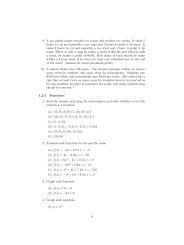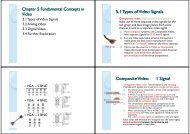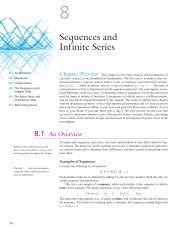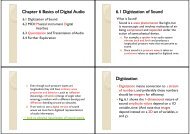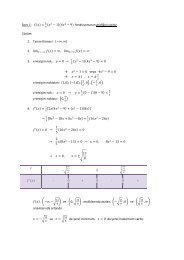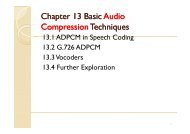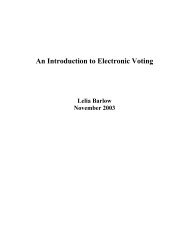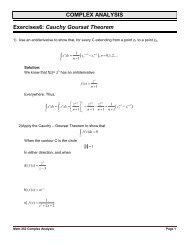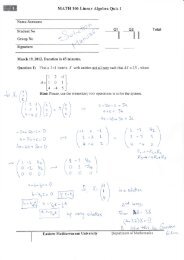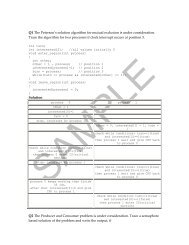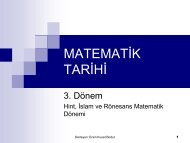Chapter 2
Chapter 2
Chapter 2
Create successful ePaper yourself
Turn your PDF publications into a flip-book with our unique Google optimized e-Paper software.
Math 322 Probability and Statistical Methods<br />
<strong>Chapter</strong> II PROBABILITY<br />
Key words: Sample space, sample point, tree diagram, events, complement, union and<br />
intersection of an event, mutually exclusive events; Counting techniques: multiplication rule,<br />
permutation, combination, probability of an event; Additive rules; Conditional probability,<br />
independent events, multiplicative rules, Bayes’ rule.<br />
SAMPLE SPACE<br />
Sample Space. The set of all possible outcomes of a statistical experiment is called a Sample<br />
space. It is represented by the symbol S.<br />
Sample Point. Each outcome in a sample space is called an element or a sample point of the<br />
sample space.<br />
Example 1. (a) Consider the experiment of tossing a coin. The sample space S of possible<br />
outcomes may be written as<br />
S={ H , T } .<br />
(b) Consider the experiment of flipping a die. Then the elements of the sample<br />
space S is listed as<br />
S={ 1,2,3,4,5,6 } .<br />
(c) Now consider the experiment of tossing a die and then a coin once. The resultant<br />
sample space can be obtained using TREE DIAGRAM.<br />
Therefore the sample sample S is<br />
S={ 1 H ,1 T,2 H , 2 T,3 H ,3 T,4 H ,4 T,5 H ,5 T,6 H,6T } .<br />
Event. An event is a subset of a sample space.<br />
For example A { 4 H ,6T<br />
}<br />
= is an event defined on S. One can define<br />
1<br />
12<br />
2 events on S.<br />
Empty set ∅ , is an impossible event and S is a sure event. Any subset of S is represented by<br />
capital letters such as A, B, C…<br />
The Complement of an Event. The complement of an event A with respect to S is the subset of<br />
c<br />
all elements of S that are not in A. The complement of A is denoted by the symbol A ' or A .<br />
The Intersection of Events. The intersection of two events A and B, denoted by the symbol<br />
A ∩ B is the event containing all elements that are common to A and B.<br />
Mutually Exclusive Events. Two events A and B are mutually exclusive or disjoint if<br />
A B<br />
∩ = ∅ , that is if A and B have no common elements in common.
The Union of Events. The union of two events A and B, denoted by the symbol A∪ B is the<br />
event containing all elements that belong to A or B or both.<br />
Important Notes. The following results may easily be verified by means of Venn diagrams.<br />
(1) A ∩ ∅ = ∅<br />
(2) A ∪ ∅ = A<br />
(3) A ∩ A'<br />
= ∅<br />
(4) A ∪ A' = S<br />
(5) S ' = ∅<br />
(6) ∅ ' = S<br />
A' ' = A<br />
(7) ( )<br />
(8) ( A B) ' ( A' B ')<br />
∩ = ∪ 1 st De Morgan Rule<br />
(9) ( A∪ B)' = A'∩ B ' 2 nd De Morgan Rule<br />
Example 2. If S = { 0,1, 2,3,4,5,6,7,8,9 } and A = { 0,2,4,6,8 } , B = { 1,3,5,7,9 } , C = { 2,3, 4,5}<br />
and D = { 1,6,7 } , list the elements of the sets corresponding to the following events:<br />
(a) A∪ C = S<br />
(b) A∩ B = ∅ ( A and B are mutually exclusive events)<br />
C ' = 0,1,6,7,8,9<br />
(c) { }<br />
(d)<br />
( C '∩ D) ∪ B = ( { 0,1,6,7,8,9 } ∩{ 1,6,7 } ) ∪{<br />
1,3,5,7,9 }<br />
= { 1,6,7 } ∪{<br />
1,3,5,7,9 }<br />
= { 1,7}<br />
(e) ( S ∩ C) ' = C ' = { 0,1,6,7,8,9 }<br />
A∩ C ∩ D'<br />
= { 2,4} ∩{<br />
0,2,3,4,5,8,9 }<br />
= { 2,4}<br />
(f)<br />
= A∩ C<br />
COUNTING SAMPLE POINTS<br />
Multiplication Rule. If an operation can be performed in n 1 ways, and if for each of these a<br />
second operation can be performed in n 2 ways, then the two operations can be performed<br />
together in n1n 2 ways.<br />
Example 1. How many breakfasts consisting of a drink and a sandwich are possible if we can<br />
select from 3 drinks and 4 kinds of sandwiches?<br />
Solution : n 1 = 3 and n 2 = 4 , therefore there are 1 2<br />
breakfast.<br />
n xn = 3x4 = 12 different ways to choose a<br />
2
Example 2. A certain shoe comes in 5 different styles with each style available in 4 distinct<br />
colors. If the store wishes to display pairs of these shoes showing all of its various styles and<br />
colors, how many different pairs would the store have on display?<br />
Solution : 5× 4 = 20 different pairs are available.<br />
Example 3. In how many ways can a true-false test consisting of 9 questions be answered?<br />
Solution : There are<br />
9<br />
2× 2× 2× 2× 2× 2× 2× 2× 2 = 2 different answers for this test.<br />
Example 4. How many even three-digit numbers can be formed fro the digits 1,2,5,6, and 9 if<br />
(a) each digit can be used only once?<br />
(b) each digit can be repeated?<br />
Solution : (a) Since the number must be even we have only 2 choices for the units position.<br />
For each of these there are 4 choices for hundreds position and 3 choices for tens positions.<br />
Therefore we can form a total of 2× 4× 3 = 24 even three-digit numbers.<br />
(b) Similarly for the units position there are 2 choices, since the numbers can be repeated we<br />
have 4 choices for the hundreds and tens positions. Hence, totally there are 2× 4× 4 = 32 even<br />
three-digit numbers.<br />
Permutation . A permutation is an arrangement of all or part of a set of objects.<br />
The number of permutations of n distinct objects is n ! .<br />
Theorem . The number of permutations of n distinct objects taken r at a time is<br />
n!<br />
n Pr<br />
=<br />
n − r !<br />
( )<br />
Example 5 . In how many ways can a Society schedule 3 speakers for 3 different meetings if<br />
they are available on any of 5 possible dates?<br />
Solution : The total number of possible schedules is<br />
5!<br />
5 P 3 = = 5.4.3 = 60 .<br />
5 − 3 !<br />
( )<br />
Theorem . The number of permutations of n distinct objects arranged in a circle is ( n − 1 ) ! .<br />
Theorem . The number of distinct permutations of n things of which 1<br />
a second kind,…, n k of a<br />
th<br />
k kind is<br />
n!<br />
n ! n !... n<br />
!<br />
1 2<br />
3<br />
k<br />
n are of one kind, 2<br />
n of
Example 6. How many different ways can 3 red, 4 yellow, and 2 blue bulbs be arranged in a<br />
string of Christmas tree lights with 9 sockets?<br />
Solution : The total number of distinct arrangements is<br />
9!<br />
= 1260 .<br />
3!4!2!<br />
Example 7. Suppose that 10 employees are to be divided among three jobs with 3 employees<br />
going to job I, 4 to job II, and 3 to job III. In how many ways can the job assignment be made?<br />
Solution.<br />
10!<br />
3!4!3! =2200<br />
Theorem. The number of combinations of n distinct objects taken r at a time is<br />
⎛ n⎞ n!<br />
nCr = ⎜ ⎟ =<br />
⎝ r ⎠ ( n − r)! r!<br />
Example 8. From 4 mathematicians and 6 computer scientists, find the number of committees<br />
that can be formed consisting of 2 mathematicians and 4 computer scientists.<br />
Solution. 4 6 ⎛ ⎞ ⎛ ⎞ 4! 6! 4.3.2!6.5.4!<br />
⎜ ⎟. ⎜ ⎟ = = = 3.6.5 = 90<br />
⎝ 2⎠ ⎝ 4⎠ 2!2! 2!4! 2!2.2.4!<br />
Probability of an Event<br />
Definition. Suppose that an experiment has associated with it a sample space S. A probability is<br />
a numerically valued function that assigns a number P ( A ) to every event A so that the<br />
following axioms hold:<br />
(1) P( A) ≥ 0<br />
(2) P( S ) = 1<br />
(3) If A1, A 2,...,<br />
is a sequence of mutually exclusive events (i.e. Ai ∩ Aj<br />
= ∅ for any<br />
i ≠ j ), then<br />
⎛ ⎞<br />
P A = P( A )<br />
∞ ∞<br />
⎜ i ⎟<br />
i<br />
⎝ i=<br />
1 ⎠ i=<br />
1<br />
∑ ∪<br />
4
Example 1. A coin is tossed twice. What is the probability that at least one head occurs?<br />
The sample space for this experiment is S { HH, HT, TH, TT}<br />
5<br />
= . If the coin is balanced,<br />
each of these outcomes would be equally likely to occur. Therefore we assign a probability w to<br />
each sample point. Then 4w=1 or w=1/4.If A represents the event of at least one head<br />
occurring, then<br />
1 1 1 3<br />
A = { HH, HT, TH } and P( A)=<br />
+ + = .<br />
4 4 4 4<br />
Theorem . If an experiment can result in any one of N different equally likely outcomes, and if<br />
exactly n of these outcomes correspond to event A , then the probability of event A is<br />
n<br />
P( A)<br />
=<br />
N<br />
Additive Rules<br />
Theorem. If A and B are two events, then<br />
P A ∪ B = P( A) + P( B) − P A ∩ B<br />
( ) ( )<br />
Corollary. If A and B are mutually exclusive events, then<br />
P A ∪ B = P A + P B<br />
( ) ( ) ( )<br />
Corollary. If A1 , A2 , A3 ,..., A n are mutually exclusive events, then<br />
( )<br />
P A ∪ A ∪... ∪ A = P( A ) + P( A ) + ... + P( A )<br />
1 2 n 1 2<br />
n<br />
Theorem. For three events A , B and C ,<br />
P A ∪ B ∪ C = P( A) + P( B) + P C − P A ∩ B − P A ∩ C − P B ∩ C + P A ∩ B ∩ C .<br />
( ) ( ) ( ) ( ) ( ) ( )<br />
Example 1. What is the probability of getting a total 7 or 11 when a pair of dice are tossed?<br />
Solution. Let A : event that 7 occurs ; B : event that 11 occurs , therefore<br />
1 1 2<br />
P( A ∪ B) = P( A) + P( B)<br />
= + =<br />
6 18 9<br />
Theorem. If A and A′ are complementary events, then<br />
P( A) + P( A′ ) = 1<br />
Example 2. In a random experiment it is known that P( A) = 0.35, P( A ∩ B)<br />
= 0.19,<br />
and P( A′ ∩ B′<br />
) = 0.15. Calculate P( B ) .
Exercises<br />
Exercise 1. A pair of dice is tossed. Find the probability of getting<br />
(a) a total of 8<br />
(b) at most a total of 5.<br />
Exercise 2. Two cards are drawn in succession from a deck without replacement. What is the<br />
probability that both cards are greater than 3 and less than 9?<br />
Exercise 3. If 3 books are picked at random from a shelf containing 5 novels, 3 books of poems,<br />
and a dictionary, what is the probability that<br />
(a) the dictionary is selected?<br />
(b) 2 novels and 1 book of poems are selected?<br />
Exercise 4. If 2 of the 10 employees are female and 8 male, what is the probability that exactly<br />
one female gets selected among the three?<br />
Exercise 5. A package of 6 light bulbs contain 2 defective bulbs. If 3 bulbs are selected for use,<br />
find the probability that none is defective.<br />
Exercise 6. How many four-digit serial numbers can be formed if no digit is to be repeated<br />
within any one number?<br />
Exercise 7. Seven applicants have applied for two jobs. How many ways can the jobs be filled if<br />
(a) the first person chosen receives a higher salary than the second?<br />
(b) There are no differences between the jobs?<br />
Exercise 8. From a group of 4 men and 5 women, how many committees of size 3 are possible<br />
(a) with no restrictions?<br />
(b) with 1 man and 2 women?<br />
(c) with 2 men and 1 woman if a certain man must be on the committee?<br />
Exercise 9. In how many ways can the letters of the word ‘KRAKATOA’ be arranged?<br />
6
Conditional Probability and Independence<br />
The probability of an event B occurring when it is known that some event A has occurred is<br />
called a conditional probability and is denoted by P( B A ) .<br />
Definition. The conditional probability of B , given A , denoted by P( B A ) , is defined by<br />
( ∩ )<br />
provided that ( ) 0<br />
P A B<br />
P( B A) = P A > .<br />
P( A)<br />
Example 1. The probability that a regularly scheduled flight departs on time is P( D ) = 0.83 ; the<br />
probability that it arrives on time is P( A ) = 0.82 ; and the probability that it departs and arrives<br />
on time is P( D ∩ A)<br />
= 0.78. Find the probability that a plane<br />
(a) arrives on time given that it departed on time.<br />
(b) departed on time given that it has arrived on time.<br />
Solution. (a)<br />
(b)<br />
P( A ∩ D)<br />
0.78<br />
P( A D)<br />
= =<br />
P( D)<br />
0.83<br />
P( A ∩ D)<br />
0.78<br />
P( D A)<br />
= =<br />
P( A)<br />
0.82<br />
Definition. Two events A and B are said to be independent if<br />
P A B = P A<br />
or<br />
This is equivalent to stating that<br />
( ) ( )<br />
P( B A) = P( B)<br />
.<br />
P( A ∩ B) = P( A) P( B)<br />
.<br />
Exercise 1. Consider two mutually exclusive (disjoint) events, A and B , such that P( A ) > 0<br />
and P( B ) > 0 . Are A and B independent? Give a proof for your answer.<br />
Exercise 2. Let A and B be two events with<br />
(a) P( A ∩ B)<br />
(b) P( A′ ∩ B′<br />
)<br />
(c) P( A / B′ )<br />
(d) P( B A )<br />
(e) Determine whether A and B are independent or not.<br />
1 3 1<br />
P( A) = , P( B′ ) = and P( A ∪ B)<br />
= . Find<br />
3 4 2<br />
7
Multiplicative Rules<br />
Theorem. If in an experiment the events A and B can both occur, then<br />
P ( A ∩ B) = P ( A) P ( B A)<br />
.<br />
Example 1. One bag contains 4 white balls and 3 black balls, and second bag contains 3 white<br />
and 5 black balls. One ball is drawn from the first bag and placed unseen in the second bag.<br />
What is the probability that a ball now drawn from the second bag is black?<br />
Solution. Let B1 , B2 and W 1 represent, respectively, the drawing of a black ball from bag1, a<br />
black ball from bag 2 and a white ball from bag 1.<br />
{ ( 1 ∩ 2 ) ( 1 ∩ 2 ) } = ( 1 ∩ 2 ) + ( 1 ∩ 2 )<br />
= P ( B1 ) P ( B2 B1 ) + P ( W1 ) P ( B2 W1<br />
)<br />
P B B or W B P B B P W B<br />
3 6 4 5 38<br />
= . + . =<br />
7 9 7 9 63<br />
Example 2. Three cards are drawn in succession, without replacement, from an ordinary deck of<br />
playing cards. Find the probability that the event A1 ∩ A2 ∩ A3<br />
occurs, where A 1 is the event that<br />
the first card is a red ace, 2 A is the event that the second card is a 10 or a jack, and A 3 is the<br />
event that the third card is greater than 3 but less than 7.<br />
Solution. First we define the events as<br />
A : the first card is a red ace<br />
1<br />
A : the second cars is a 10 or jack<br />
2<br />
A : the third card is greater than 3 but less than 7<br />
3<br />
2 8 12 8<br />
∩ ∩ = ( ) ∩ = . . = .<br />
52 51 50 5525<br />
Then, P( A1 A2 A3 ) P A1 P( A2 A1 ) P( A3 A1 A2<br />
)<br />
Example 3. A coin is biased so that a head is twice as likely to occur as atail. If the coin is tossed<br />
3 times, what is the probability of getting 2 tails and 1 head?<br />
Solution. The sample space for the experiment consists of the 8 elements,<br />
S = HHH , HHT, HTH , THH , HTT , THT , TTH , TTT .<br />
{ }<br />
Let A be the event of getting 2 tails and 1 head in the 3 tosses of an unfair coin. Then<br />
A = TTH , THT, HTT .<br />
{ }<br />
Assigning probabilities of w and 2w for getting a tail and a head, respectively, we have<br />
1 2 1<br />
3w = 1 or w = . Hence P( H ) = and P( T ) = . Since the outcomes on each of the 3 tosses are<br />
3 3 3<br />
independent, it follows that<br />
8
Exercises<br />
P( A) = P( TTH ) + P( HTT ) + P( THT )<br />
= P( T ) P( T ) P( H ) + P( H ) P( T ) P( T ) + P( T ) P( H ) P( T )<br />
1 1 2 2 1 1 1 2 1 2<br />
= . . + . . + . . = .<br />
3 3 3 3 3 3 3 3 3 9<br />
Exercise 1. In an experiment to study the relationship of hypertension and smpking habits, the<br />
following data are collected for 180 individuals:<br />
Non- Moderate Heavy<br />
smokers smokers Smokers<br />
Hypertension 21 36 30<br />
No Hypertension 48 26 19<br />
If one of these individuals is selected at random, find the probability that the person is<br />
(a) experiencing hypertension, given that the person is a heavy smoker;<br />
(b) a non-smoker, given that the person is experiencing no hypertension.<br />
Exercise 2. The probability that a married man watches a certain television show is 0.4 and the<br />
probability that a married woman watches the show is 0.5. The probability that a man watches<br />
the show, given that his wife does, is 0.7. Find the probability that<br />
(a) a married couple watches the show;<br />
(b) a wife watches the show given that her husband does;<br />
(c) at least one person of a married couple will watch the show.<br />
Exercise 3. The probability that Ayse will be alive in 20 years is 0.7 and the probability that Ali<br />
will be alive in 20 years is 0.9. If we assume independence for both, what is the probability that<br />
neither will be alive in 20 years?<br />
Exercise 4. Assume that the events A and B satisfy<br />
P( A) = P( B) = P( B A′ ) = 1/ 3<br />
where A′ is the complement of A . What is P( A′ ∪ B)<br />
?<br />
9
Bayes’ Rule<br />
The following theorem, sometimes is called the Theorem of Total Probability or the Rule of<br />
Elimination.<br />
Theorem. If the events B1 , B2 ,...., B k constitute a partition of the sample space S such that<br />
P( B ) ≠ 0 for i = 1, 2,... k,<br />
then for any event A of S ,<br />
i<br />
k<br />
( ) = ∑ ( i ∩<br />
k<br />
) = ∑ ( i ) ( i ).<br />
i= 1 i=<br />
1<br />
P A P B A P B P A B<br />
Theorem (Bayes’ Rule). If the events B1 , B2 ,...., B k constitute a partition of the sample space<br />
S , where P( B ) ≠ 0 for i = 1,2,... k,<br />
then for any event A in S such that P( A) ≠ 0,<br />
i<br />
( ∩ )<br />
P( Br A)<br />
=<br />
P Br k<br />
A<br />
=<br />
P( Br ) P( A Br<br />
)<br />
k<br />
P( B ∩ A) P( B ) P( A B )<br />
∑ ∑<br />
i i i<br />
i= 1 i=<br />
1<br />
10<br />
for r = 1, 2,...., k<br />
Example 1. A group consists of 60% of girl students and 40% of boy students. 20% of boy<br />
students and 50% of girl students are Cypriots. If a student is taken at random from this group,<br />
(a) what is the probability that this student is Cypriot?<br />
(b) If at random selected student from this group is Cypriot, what is the probability that this<br />
student is a girl?<br />
Solution. Consider the following events:<br />
G: student is a girl<br />
B: student is a boy<br />
C: student is Cypriot<br />
P( G) = 0.60 , P( B)<br />
= 0.40 , P( C B) = 0.20, P( C G)<br />
= 0.50 .<br />
(a)<br />
(b)<br />
P( C) = P( B) P( C B) + P( G) P( C G)<br />
( ) ( )( )<br />
=(0.40) 0.20 + 0.60 0.50 = 0.38<br />
( )( )<br />
P( G ∩ C)<br />
P( G) P( C G)<br />
0.60 0.50<br />
P( G C)<br />
= = = = 0.79 .<br />
P( C) P( C)<br />
0.38<br />
Exercise. In a certain assembly plant, three machines, 1 2 3<br />
, and<br />
M M M make 30%,45% and 25%,<br />
respectively, of the products. It is known from past experience that 2%, 3%, and 2% of the<br />
product made by each machine, respectively, are defective. Find the probability that a randomly<br />
selected product is defective.



